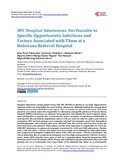Please use this identifier to cite or link to this item:
https://cris.library.msu.ac.zw//handle/11408/975Full metadata record
| DC Field | Value | Language |
|---|---|---|
| dc.contributor.author | Tlhakanelo, John T. | |
| dc.contributor.author | Tshikuka, Jose G. | |
| dc.contributor.author | Molefi, Mooketsi | |
| dc.contributor.author | Magafu, Mgaywa G. M. D. | |
| dc.contributor.author | Masupe, Tiny | |
| dc.contributor.author | Matchaba-Hove, Reginald | |
| dc.date.accessioned | 2016-04-24T09:54:55Z | |
| dc.date.available | 2016-04-24T09:54:55Z | |
| dc.date.issued | 2015 | |
| dc.identifier.uri | http://hdl.handle.net/11408/975 | |
| dc.description.abstract | Hospital admissions among people living with HIV (PLWH) in Botswana are high. Opportunistic infections (OIs) are responsible for most of these admissions. Although leading OIs causing these admissions have been identified in the region, their correlates are poorly understood. This study aimed to: 1) evaluate major OIs responsible for admissions among HIV patients at Princess Marina Hospital (PMH) in Botswana; 2) estimate the proportion and identify the most frequent admissions attributable to specific OIs; 3) characterize major correlates of admissions attributable to each specific OIs and identify populations most at risk as a base for effective policy and resource orientation. HIV infected patients were randomly selected from hospital record lists. Biomedical, sociodemographic and economic data were collected from the records and from face-to-face patient interviews and analyzed. Tuberculosis was the most important OI responsible for 234.6 per 1000 HIV admissions. Cryptococcal meningitis accounted for 162.0 per 1000 admissions. Patients with a CD4-cell count < 350/µL and males were more likely to be admitted for both tuberculosis and cryptococcal meningitis compared to those with a CD4-cell count > 350/µL and females. The risk of admission due to cryptococcal meningitis was also high among patients with low socioeconomic status (SES). Females were more at risk for Cryptosporidium, Bacterial pneumonia (BP), Pneumocystis Carinii Pneumonia (PCP), Herpes and candidiasis-specific admissions than male and, patients not on co-trimoxazole were more likely to be admitted than those on co-trimoxazole.Comprehensive implementation strategies to address OIs among PLWH are needed. To be effective, such strategies should address not only biomedical factors but should also focus on PLWH’s SES. | en_US |
| dc.language.iso | en | en_US |
| dc.publisher | Scientific Research Publishing | en_US |
| dc.relation.ispartofseries | World Journal of AIDS;Vol.5; p.175-181 | |
| dc.subject | Botswana, people living with HIV, opportunistic infections, | en_US |
| dc.subject | Hospital admissions | en_US |
| dc.title | HIV hospital admissions attributable to specific opportunistic infections and factors associated with them at a Botswana Referral Hospital | en_US |
| dc.type | Article | en_US |
| item.fulltext | With Fulltext | - |
| item.openairecristype | http://purl.org/coar/resource_type/c_18cf | - |
| item.languageiso639-1 | en | - |
| item.grantfulltext | open | - |
| item.openairetype | Article | - |
| item.cerifentitytype | Publications | - |
| Appears in Collections: | Research Papers | |
Files in This Item:
| File | Description | Size | Format | |
|---|---|---|---|---|
| WJA_2015083114051914.pdf | 252.4 kB | Adobe PDF |  View/Open |
Items in MSUIR are protected by copyright, with all rights reserved, unless otherwise indicated.



